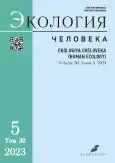Response of the cardiovascular system to heart rate variability biofeedback intervention in adolescents with different autonomic nervous tone living in northern and southern regions
- 作者: Demin D.B.1
-
隶属关系:
- N. Laverov Federal Center for Integrated Arctic Research of the Ural Branch of the Russian Academy of Sciences
- 期: 卷 30, 编号 5 (2023)
- 页面: 375-384
- 栏目: ORIGINAL STUDY ARTICLES
- URL: https://journals.rcsi.science/1728-0869/article/view/254618
- DOI: https://doi.org/10.17816/humeco321968
- ID: 254618
如何引用文章
全文:
详细
BACKGROUND: The cardiovascular responses of adolescents during self-regulation are contingent upon their initial autonomic tone and place of residence.
AIM: To investigate the dynamics of cardiovascular system indices during heart rate variability biofeedback (HRV BF) training in adolescents with different initial autonomic regulation of heart rhythm, taking into account their residence in the northern and southern regions.
MATERIAL AND METHODS: Schoolchildren aged 16–17 years, residents of the northwestern (n=55), northeastern (n=55) and southern (n=55) regions of the Russian Federation were examined. Heart rate variability (HRV) and blood pressure (BP) were recorded. Participants were divided into the following groups according to their baseline autonomic regulation of cardiac rhythm: vagotonics, normotonics and sympathotonics. Normotonics and sympathotonics additionally had a one-time HRV BF session to increase parasympathetic influences on heart rhythm.
RESULTS: The northwestern/northeastern/southern samples revealed 29/7/16% vagotonics; 42/47/49% normotonics; and 29/46/35% sympathotonics. BP was significantly greater in sympathotonics compared to vagotonics and normotonics in in the northeastern region and sympathotonics in the northwestern and southern regions. HRV BF training was successful in all participants: HRV parameters responded to a greater extent in sympathotonics living in the northwestern region while their BP and baroreflex levels were relatively stable. Sympathotonics of the northeastern and southern regions were characterized by preservation of elevated HR after HRV BF accompanied by a significant decrease in BP and a pronounced baroreflex response.
CONCLUSION: In the northwestern region, adolescents who are mainly decendants of migrants from the southern regions typically have sympathicotonia and increased vascular response to HRV BF. The descendants of natives of the northwestern region apparently inherited more advanced mechanisms of cardiovascular regulations in the conditions of the Arctic.
作者简介
Denis Demin
N. Laverov Federal Center for Integrated Arctic Research of the Ural Branch of the Russian Academy of Sciences
编辑信件的主要联系方式.
Email: denisdemin@mail.ru
ORCID iD: 0000-0001-7912-9226
SPIN 代码: 6565-4657
MD, Dr. Sci. (Med.), senior research associate
俄罗斯联邦, 249 Lomonosov avenue, 163000, Arkhangelsk参考
- Dyakovich MP, Dyakovich OA. Health related quality of life of adolescents living in the Yamal-Nenets autonomous area. Ekologiya cheloveka (Human Ecology). 2017;24(3):43–48. (In Russ). doi: 10.33396/1728-0869-2017-3-43-48
- Korchin VI, Korchina TYa, Ternikova EM, et al. Influence of climatic and geographical factors of the Yamalo-Nenets Autonomous Okrug on the health of its population (review). Journal of Medical and Biological Research. 2021;9(1):77–88. (In Russ). doi: 10.37482/2687-1491-Z046
- Artamonova SU, Ammosova AM, Zakharova NM, et al. The state of autonomic nervous system in teenagers of the city of Yakutsk. Vestnik of North-Eastern Federal University. Medical Sciences. 2018;(4):33–38. (In Russ). doi: 10.25587/SVFU.2018.4(13).20742
- Lytaev SA, Tolstova EA. Vegetative status with arterial hypertension in the indigenous population of the Far North and migrants. Pediatrician (St. Petersburg). 2016;7(3):56–62. (In Russ). doi: 10.17816/PED7356-62
- Korobitsyna EV, Mel’kova LA, Gudkov AB. Impact of local hand and foot skin cooling on peripheral hemodynamic parameters in young men and women in the European North of Russia. Vestnik Severnogo (Arkticheskogo) federal’nogo universiteta. Seria: Mediko-biologicheskie nauki. 2016;(4):22–29. (In Russ). doi: 10.17238/issn2308-3174.2016.4.22
- Poskotinova LV. Vegetativnaja reguljacija ritma serdca i jendokrinnyj status molodezhi v uslovijah Evropejskogo Severa Rossii. Yekaterinburg: Ural Branch of RAS. 2010. 232 p. (In Russ).
- Lehrer P, Kaur K, Sharma A. Heart rate variability biofeedback improves emotional and physical health and performance: a systematic review and meta analysis. Appl Psychophysiol Biofeedback. 2020;45(3):109–129. doi: 10.1007/s10484-020-09466-z
- Baevsky RМ, Chernikova AG. Heart rate variability analysis: physiological foundations and main methods. Cardiometry. 2017;(10):66–76. doi: 10.12710/cardiometry.2017.6676
- Singh N, Moneghetti KJ, Christle JW, et al. Heart rate variability: an old metric with new meaning in the era of using mhealth technologies for health and exercise training guidance. Part one: physiology and methods. Arrhythm Electrophysiol Rev. 2018;7(3):193–198. doi: 10.15420/aer.2018.27.2
- Oikawa LO. Characteristics of possible "Polar adaptation" by long-term wintering in antarctica observed through analysis of heart rate variability (HRV) components representing autonomic nervous system (ANS) response. Journal of the Neurological Sciences. 2017;381:935. doi: 10.1016/j.jns.2017.08.2631
- Demin DB, Poskotinova LV, Krivonogova EV. EЕG reactions during heart rate variability biofeedback procedure in adolescents with different autonomic tone living in Northern areas. Ekologiya cheloveka (Human Ecology). 2016;23(10):23–30. (In Russ). doi: 10.33396/1728-0869-2016-10-23-30
- Lin G, Xiang Q, Fu X, et al. Heart rate variability biofeedback decreases blood pressure in prehypertensive subjects by improving autonomic function and baroreflex. J Altern Complement Med. 2012;18(2):143–152. doi: 10.1089/acm.2010.0607
- Nolan RP, Floras JS, Harvey PJ, et al. Behavioral neurocardiac training in hypertension: a randomized, controlled trial. Hypertension. 2010;55(4):1033–1039. doi: 10.1161/HYPERTENSIONAHA.109.146233
- Olsson EM, El Alaoui S, Carlberg B, et al. Internet-based biofeedback-assisted relaxation training in the treatment of hypertension: a pilot study. Appl Psychophysiol Biofeedback. 2010;35(2):163–170. doi: 10.1007/s10484-009-9126-x
- Moravec CS. Biofeedback therapy in cardiovascular disease: rationale and research overview. Cleve Clin J Med. 2008; 75 Suppl. 2:S35–S38. doi: 10.3949/ccjm.75.suppl_2.s35
补充文件







